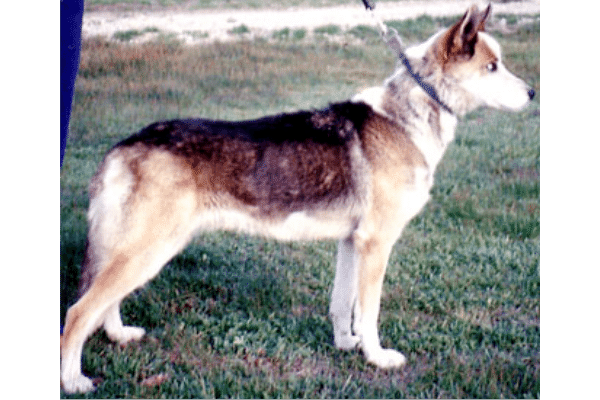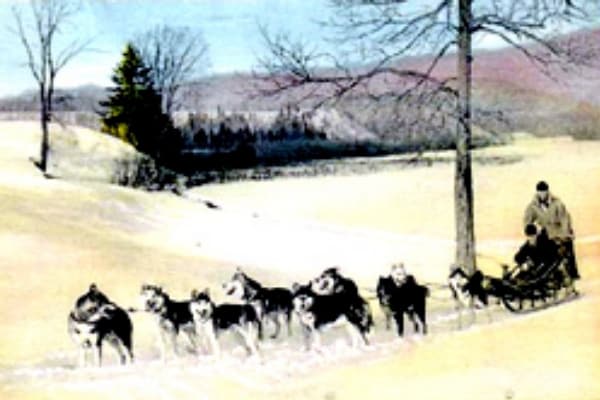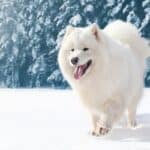
Almost everyone knows of the Siberian Husky breed – beautiful, friendly with high energy, and a huge personality, but did you know about their interesting history? It involves the Seppala Siberians.
If you’ve seen the Disney+ movie “Togo,” you understand the newfound curiosity about this wolf-like breed. So, what exactly are they?
What is a Seppala Siberian Husky? Seppala Siberian Huskies are a line of sled dogs established by Leonhard Seppala. This is a working breed designed to pull sleds in extreme conditions. They average 21-23 inches tall and typically weigh 40-50 pounds. They are comparative in size and appearance to Siberian Huskies with a rangier build.
There is plenty of confusion regarding this wolf-like dog breed. Where did they come from? Are they similar to today’s Siberian Husky?
Let’s find out what there is to know about this rare Siberian sled dog.
About Seppala Siberian Husky
The Seppala Siberian Husky is an arctic dog breed that shares a striking resemblance to a wolf but is more well known for its abilities and work ethic.
How Seppala Siberians Were Created
Between 1908 to 1930, dogs from eastern Siberia were imported into Alaska and other parts of the United States.
These dogs were found to be useful and superior in sled hauling during the Yukon and Nome Gold Rush era.
One Norwegian gold seeker and an esteemed dog driver, Leonhard Seppala, established a bloodline of Siberian sled dogs from the earlier Siberian import stock 1914 through 1930.
In 1926, he took his dogs on a publicity tour around the eastern USA after the famous Nome Serum Run.
In 1930, Seppala partnered with Elizabeth Ricker to establish the first “Seppala Kennel” in Poland Spring, Maine. At the same time, the USA-based AKC first registered the “Siberian Husky” breed.
The following year, the key stock from the Seppala kennel went to Harry Wheeler, and other pure strain dogs went to Charles and Alex Belford, William Shearer III, and later on, J.D. McFaul.
As the development of the early AKC Siberian Husky breed continued, the breed was firmly on the path to becoming show dogs.
At this time, show and racing bloodlines were fairly mixed by many breeders.
In 1997 the Seppala Siberian Sleddog (SSSD), a breed in its own right, was officially chartered in Canada as an “evolving breed.”
During that time, the Working Canine Association of Canada (WCAC), was chartered as sole record-keeping organization for the breed.
Seppala Siberian Husky Appearance
Many Seppala Siberian sled dogs are pure white or a combination of buff and white.
Others have a nearly all-dark appearance with either a very dark, black, or charcoal gray coloring in both face and body with white only on their feel and the tip of their tails.
The gray coloring in Seppala dogs varies from blue-gray to brownish gray. Seppala dogs can have a sable coloring in rare cases but still typically show black-tipped guard hairs.
Red and copper coloring and liver noses common in other arctic breeds are absent in Seppala dogs. Typically, their lips, noses, and eye rims are all black, including those with sable colors.
Distinctive markings in Seppala dogs come in a wide variety, including:
- Piebald spotting
- Agouti pattern: wild-type coloration often called the wolf sable where there are several alternating black and tan bands.
- Splash coat or white markings on the body
- Saddleback pattern: black markings on the head and limbs that fades out as the puppy grows and turn into a pattern of dark hairs that looks similar to the shape of an English riding saddle
Compared to other sled dogs, Seppalas appear to be smaller and lighter in build. Seppala dogs are medium-sized dogs with height and weight range of:
- Mature males: 21-25 inches in height, 38-65 pounds weight.
- Mature females: 19-23 inches in height, 30-55 pounds weight.
Seppala Siberian Husky Purpose

Seppala Siberians may be active and energetic, but they are also very docile and trainable. They exist with the primary purpose of pulling a dogsled in very cold regions.
Seppala dogs have the endurance, strength, speed, and versatility to serve various purposes as a general-purpose arctic sled dog.
That includes rapid long-distance dogsled transport; freighting; long-, mid-, and short-distance sledding racing; recreational dogsledding; dog packing; passenger touring; and skijoring.
Seppala Siberian Sleddog Temperament
Seppala Siberians are active and often inquisitive, but they can also show excellent reserve when facing strangers.
The dog breed’s most defining features are its docile, cooperative, and outstanding trainability with a stable and serious temperament.
In ideal scenarios, Seppala sled dogs are highly aware of danger without being fearful and don’t show viciousness or aggressiveness toward their handler.
Unlike other arctic dog breeds, Seppalas are known to have a highly bonded nature to their owners and often show a high degree of affection.
That makes them an ideal choice for both working and recreational dogsledding settings.
Why Seppala Siberian Huskies Became Popular
Seppala Siberians were primarily working sled dogs, but they rose to popularity, particularly in the western USA, because of mid-distance racing.
They first came to the limelight in Alaska after dominating the All-Alaska Sweepstakes distance race from 1914 to 1917.
In the wake of the 2019 Disney movie Togo, curiosity over the Seppala Siberian Husky breed rose again.
In fact, there has been a major surge of breeders claiming to have and sell Seppala dogs to cash in on the breed’s popularity among unsuspecting buyers.
How Seppala Siberians Differ From Today’s Siberian Huskies
The Siberian Huskies of modern times are tagged as show lines, while the Seppala Siberian sled dogs, since the start, have been utility dogs from working lines.
While they share many physical traits, both with wolf-like appearances, there are significant differences between these two dog breeds.
In comparison, Seppala Siberians have significantly longer bodies and legs than Siberian Huskies.
They are also lighter in build and have taller, more erect ears set closer together than the show dog Siberian Husky breed.
Generally, you can see Siberian Huskies have a more standardized appearance.
Meanwhile, the Seppala sled dogs are mainly bred for performance.
As such, their appearances, colors, and markings vary greatly, but typically, they are less flashily marked than the show dog lines.
If you want a family pet, go for a Siberian Husky, but if you want a working dog that can pull a sled or a cart, get a Seppala Siberian Husky… if you can find one.
Are Seppala Siberians Recognized by the AKC?
No, the Seppala Siberian sled dog is not a breed recognized by the American Kennel Club.
However, there are pure Seppala dogs in the AKC registry, but they are listed as a Siberian Husky bloodline and not “Seppala Siberian.”
Currently, the only existing breed club for Seppala Siberian dogs is the International Seppala Siberian Sleddog Club, which is recognized by the Continental Kennel Club and not AKC.
The ISSSC set forth the Seppala breed standard and established the club to manage the preservation of the breed.
Number of Pure Seppala Siberians Sleddogs Left Today
Because it is difficult to distinguish a pure-strain Seppala dog from one with a mixed Seppala lineage, there is no accurate census to determine the remaining number of pure Seppala Siberians remaining today.
It is likely that there are only a few hundred pure Sepallas left.
Why There Are So Few Seppala Siberians Left
Seppala dogs had started to become scarce in the 1960s when many of the breeders and kennels retired – Harry Wheeler (1950), William Shearer (1956), and particularly J.D. McFaul (1963), but that’s only part of it.
Another contributing factor was that interest in Seppala dogs as a racing breed waned during the 1960s.
Racers turned to speedier Alaskan Huskies while show dog breeders turned to flashier marked bloodlines instead of the original working Siberians.
By this time, there are only a handful of Seppala breeders remaining, but they neither did enough breeding nor sold enough litters to preserve the “pure” Seppala strain.
Are Seppala Siberian Huskies Still Being Bred Today?
Yes, there are still Seppala Siberian Huskies being actively bred today. However, their pureness can vary greatly.
The “Seppala Siberian Sleddogs” distinction given by the Working Dog Association of Canada is for those with 95% genetics derived from the 10 Markovo-Seppineau foundation dogs.
For the ISSSC, all Siberians with at least 93% genetics derived from the nine Harry Wheeler foundation dogs can be considered as Seppala Siberian Sleddog.
The Future of the Seppala Siberian Husky
There are still supporters that are looking forward to the Seppala Siberian breed continuing, but if you ask Jeffrey Bragg, he doesn’t expect the Seppala Siberian Husky to survive in the coming years.
According to him (in 2012), Seppala dogs are back to where they were in 1969 and will face extinction in the next 15 years or so.
Can You Still Get a Seppala Siberian?
Getting a “pure” original Seppala bloodline is rare, but there are still a small number of them, especially in Canadian provinces.
Again, it all depends on whom you ask about what a purebred Seppala is because there are still opposing views in existence.
Today, you are more likely going to get a “percentage” Seppala (meaning a very low percentage) than a purebred Seppala Siberian.
Seppala Siberian Cost
While rare, Seppala Siberian isn’t the most expensive of the Husky breeds. They can cost anywhere between $600 and $800 a pup, significantly cheaper than Siberian Huskies.
However, expect to pay more for pedigree certification.
List of Seppala Siberian Breeders Who Claim To Have Pure Lines
A “pure” Seppala, as defined by Jeffrey Bragg, is a Siberian dog wholly and not just “mostly” descended from either Leonhard Seppala’s dogs or from Serbia import stock.
They have been traditionally chosen only for working sled dog capacity.
Some breeders and also main contributors to the contemporary Seppala bloodlines at present include:
- Seppala Kennels (J. Jeffrey Bragg)
- Seppala Kennels (J.D. McFaul & C.S MacLean)
- Sepp-Alta Kennels (Douglas Willet)
- Seppineau Kennels (Gary Egelston)
- Bryar Kennels (Keith Bryar)
- Foxstand Kennels (Willian Shearer III)
- Gagnon Kennels (Alan Gagnon)
- Malamak Kennels (J. Malcolm McDougall)
- Cold River Kennels (Millie Turner)
- River View Kennels (Carolyn Ritter)
- Poland Spring Seppala Kennels (Jonathan Nathaniel Hayes)
Conclusion
Seppala is a beloved breed to many, and while some people think that the Seppala as a breed is dead, there are still others not ready to throw in the towel.
But the most important part of saving the Seppala is first to clearly define what a Seppala Siberian Sleddog really is, and that is no longer an easy task.




